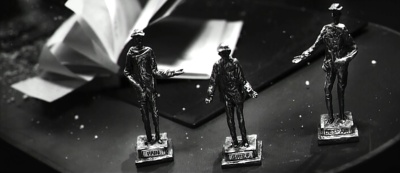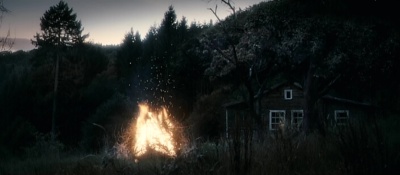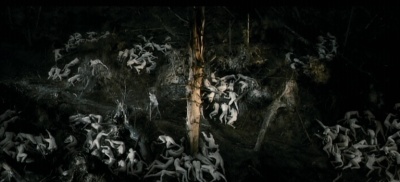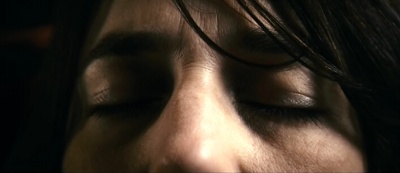Lars Von Trier’s Antichrist: Executioner at the Alter of the Other, Part 2
A Closer Examination of the Trial

I return now to the passionate love scene of the prologue. Several elements of the way blame operates within the film are immediately present in it. The “triple x” shot that has sparked controversy among reviewers seems to invite and play with accusations coming from the reception of the viewing audience. But in a way, the shot can be seen to enhance the sense of intimacy by intentionally corrupting what could have been a harmonious but also impersonal love scene, one with a generic appearance through which advertising has harnessed every romantic signifier. In fact, the “deep penetration shot” fetishized one way or the other by reviewers is anything but a realistic pornographic image. On the one hand, it resembles an anal sex shot, with the penetration placed too high up near the torso to have been vaginal. This makes no rational sense given the frontal positioning of the love scene into which the shot intervenes. It also looks like a shot of a penis entering a groin without legs, because the delineation of the legs are partially transparent and faded out. This could be understood as more of an impression of sexual experience which twists the body in physically impossible ways and dissolves or distorts the placement of limbs. It is neither a porn shot nor a representation of “natural” sex. It creates the appearance of the intervention of a demonic rite which might be how some audience members would understand the penetration of a sexually explicit set of frames into a love scene. Set in a church-like, apparently newly renovated home with an immaculate stainless steel dryer churning a pristine white towel, tumbling it to its cyclical end; in the ‘washed and dried’ sanctuary of an immaculate and Christian construct, the holiness of the lovemaking sequence is disturbed by the triple x shot as a representation of the forces and powers of the ecstatic, sensory, embodied and intimate imagination.

As the opening lovemaking sequence progresses, it becomes clear that there are many sonic interruptions in proximity that would have been heard by the couple, but cannot in this holy temple of sex where sound is drowned out by a ritualized drama of operatic music. What disturbs the child and makes him open the gate of his crib is the sound of the telephone ringing, visually depicted on the handset. Though inaudible within the soundtrack, there is also a glass bottle of vodka falling over, and most importantly, a group of presumably heavy metal statues being pushed onto the floor as the child ascends to the window. The couples’ obliviousness to the noise underscores their role as an act of extreme negligence, and also as a kind of violent act that goes beyond the marital bliss condoned by a biblical marriage. Their sex is a kind of holy rite of infidels that cannot be represented by a lovemaking scene without unholy disturbances. The metal objects that fall are in fact statues of humans with their arms stretched out as if ready to embrace. The child clears the statues off the table the way a drunk would clear a space. The names on the pedestals of the human figurines are “grief,” “pain” and “despair.” Apparently, despite the perfect household in a privatized world of the nuclear family, the experience of expropriation lingers.

The child falling, climbing or diving out of the window (all are equally plausible) has a metaphorical dimension which extends the power of the scene beyond its literal meaning. The fact that the child is the creative product of precisely the sexual ecstasy that kills him through neglect, makes the tragedy convertible to many other experiences of irresponsibility, consequence, and guilt that accompany complete emotional and physical abandon. It seems that the modern Christian world offers much in punishment but comparatively few safeguards for those rituals that blend total physical and emotional intensity. Pornographic advertisement and bridal worlds over-represent varying versions of love, sex and intimacy in relatively simple and authoritarian ways, but they are unable to iterate the bonds of passion powerful enough to drive humans to ecstasies so great that they can be confused or collided with the brink of death and despair. The intimate sexuality Von Trier presents in this opening scene is the fusion of a perfect form of lover’s harmony and an anti-social, yet collective and chaotic, orgasmic union. It may imagine love-making at a time when families and land were held in common, not under sole ownership, when the offspring of a common protectorate might have withstood their parents’ ecstasy and oblivion.
The prologue might be described as follows: a child falls out through an open window during his parents’ sex act. But there is no agency in this. It is difficult not to be reminded of Freud’s encounters with “a child is being beaten” which call up fear, sexual excitation and also triumph in sibling rivalry for those child patients who felt they gained parental approval when their siblings were beaten but they were not. Sibling rivalry is a kind of triad, a competition for the parent’s love in which one of the two siblings feels ‘extra’ to the intimate bond with the parent. It is possible to read the opening sequence of Antichrist as a triad in which the third party, the child, was extra in a similar kind of way. But instead of sibling rivalry, where a child competes for the mother’s attention with another child, the child in Antichrist was competing for some kind of parental attention: son competes with the father for the mother’s love? In this passion scene staged to opera music, there is no room for the child to wander from his crib during his parents’ sex rites. In a Christian capitalist regime, moralizing Christian notions about what the family should be socially, audible in the current political Right’s regulations of the family and the privileging of the fetus over the mother in the discourse against abortion, contribute to the inquest over the guilty party. For the child could not have been a part of the domestically normal sex without disturbing and thereby invoking the immoral and twisted. After the child became ‘extra’ to the diad of the hetero coupling and died as a result of being ignored and not fitting into the domestic scene at that moment, it becomes necessary to spend the rest of the narrative trying to figure out who should have been the third wheel (which parent should have died instead of the child) if “innocent” children are not supposed to die. When She states “you were always so distant from me and Nick” she invokes him as the absent father. There she suggests her claim to the primary love with the child; that the primary bond should have been between mother and child, not between mother and father or between father and son. But in making this subtle accusation, and also laying claim to this status, she is also taking complete responsibility for the child’s death as his primary attachment. This is another form of self-persecution (according to He’s story) that is in concert with her later assertion that the witches ‘really’ were evil.
The question of responsibility occurs again at the end of the film: is her death an act of suicide, murder, or He’s self-defense? Leading up to his ‘solution’ of strangling her, She renders him unconscious by castrating him with a log during intercourse. She then mutilates his leg with a vice in order to not allow him to flee after she finally recognizes his emotional departure and confronts him about leaving her. Then she cuts out her own clitoris with a pair of scissors (during which the scene crosscuts to the initial lovemaking scene). He then awakens and attempts escape into the fox hole she visited earlier in her mental account of Eden. When she is tipped off to his location by the crow which, according to her notes, represents despair, she digs him out with a shovel. She simultaneously buries and resurrects him before dragging him back to the cabin. He asks her: “are you going to kill to me?” She replies, “Not yet. The three beggars aren’t here yet.” She adds “When the beggars come, somebody has to die.” At that point, he removes the vice and the weight threaded through his leg and manages to strangle her after a struggle.
Her self-inflicted castration can be read as an attempt to express a double loss. On the one hand she loses him as lover and as husband. On the other, she castrates herself as if in a symbolic capitulation to the guilt he imposes around sex (suggested by the crosscutting to the lovemaking scene). Going from husband to therapist was already a castration, a banishing of the sexual element and embodied dimension of their relationship. The actual damage to sex organs externalizes this disavowal of the absence of sexual permission, and brings sexual frustration, abandonment and rejection out of the conflicted and banished background and uses them to puncture the foreground. Castration makes the sexual damage real and physical (not just psychological), a foreground reality undeniable even to him. Having represented himself as independent from sex, he constructs a place of innocence for himself, disowning the sexual sin that killed Nick (itself also a kind of castration as the destruction of the offspring of the father’s phallus.) Her destruction of their sex organs relates more to her cognizance that, finally, He will sacrifice She in order to maintain the vision of himself as innocent.
There are many implications to her realizing that she must become disposable for the maintenance of his self perception. In (Per)versions of Love and Hate, Renata Salecl also uses the character of Odysseus to describe the obsessional neurotic’s rejection of the desire of the Other and the reason the Other has to castrate him. Odysseus’s encounter with the Sirens is, for Salecl, a story that describes gender through allegory. Salecl writes,
Odysseus actually desires the Sirens (and maybe even wants to be desired by them); however what causes problems for him is the peculiar way the Sirens enjoy…Odysseus’s encounter with the sirens must be understood as a failure…This failed encounter between Odysseus and the Sirens can also be taken as the prototype of the impossibility of the sexual relationship between men and women. (Salecl 68)
What is central here once again, is the question of difference: “the peculiar way the Sirens enjoy.” Since Antichrist is He’s story, but also a kind of tale of gender difference, it can be understood that He’s critique relies on an idea which can only be transmitted via the following implication: that his child fell or jumped out of the window at the precise moment of his wife’s sexual climax. His narrative attack here on She’s Otherness, seeing this Otherly sexuality as implicated in murder, completely eclipses the conflict of the father-son relationship appearing in the Abraham and Isaac story that lurks in the background. But in both cases of the obsessional and his counterpart, the hysteric, Salecl writes, “it is crucial to understand their problems with desire as defences against jouissance.” (67) She goes on to say:
While the hysteric endlessly questions the desire of the Other, the obsessional does not want to know anything about this desire. Thus he wants to escape from situations that might involve confrontation, or might in any way disturb his equilibrium. Thus the encounter with the desiring Other becomes the most horrible thing for the obsessional. While the hysteric deals with the dilemma, “Am I am man or a woman?”, the obsessional agonizes over the question, “Am I dead or alive?” He hopes that with the death of the desiring Other, who continually imposes obligations on him, he will finally be free to live. The obsessional is thus a special kind of living dead, since the rituals and prohibitions he imposes on himself make him an apparently robot-like creature, apparently drained of desire. (Salecl 66)
The obsessional’s desire to kill the Other so that he can be free, may well explain the entirety of Antichrist. Another film by Lars Von Trier, Breaking the Waves (1996), holds the same kind of tension. In that film a severely disabled man, constructed as half-dead and “better forgotten” (according to the opinion of the townspeople) is the object of his wife’s passionate and persistent desire. In the exact pathology of the hysteric, she does everything she can to please him and give him a reason to live. But he would prefer for her to have sex with other men, which she eventually does. She finally decides to knowingly have sex with gangsters who kill her, with the Christian goal in mind that the sacrifice of her life will create for her husband a miracle of physical rehabilitation, which to the surprise of the town and viewers, happens. Not only does he, in the pathology of the obsessional, assume control over sexuality without participating in it, he also takes her life away in his obsessive desire to give it back (in the form of encouraging her to find intimacy elsewhere). However the reaction of his body, its ‘new-life,’ suggests that his jouissance is tied up in her annihilation.
For Antichrist, Nick’s death during the opening sex scene serves to justify the horror of encounter with the Other. On the one hand, the love scene is flawlessly operatic; on another, it is dirty, demonic and pornographic. But finally, it is dangerous and evil and leads to the quintessentially evil act of Western culture since the inception of the witch trials. The out of control body leads to infanticide and a sexual imaginary perceived by a viewing audience as “filthy” triple X sex. In this sense the He of Antichrist makes the obsessional neurotic’s case –although the diegesis doesn’t entirely support it– that the intense and passionate confrontation with the Other is dangerous and should be avoided at all costs.
On the other side, the hysteric tries to produce some kind of allure for the obsessional. This failure is described by Salecl in terms of women obsessing over their beauty through cosmetics and beauty industries. Though this is surely not happening in Antichrist, the diagnosis could easily fit with She’s submission to his exercises and emphasis on evil and her justifications of gynocide. Her allure is, in fact, the allure of the blameworthy witch, waiting to be persecuted. To read it like this would be to understand her statements of self-incrimination as attempts to reach the prototypical (male) obsessional’s secret desire to mete out judgement and have a witch to burn. Salecl says of Odysseus that “it can even be said that he finds his joiussance precisely in this ritual of thinking and planning his escape from the Sirens’ lure.” Knowing herself as the ‘evil’ that must be escaped from, offering herself up as an object for persecution represents a compromise and a sacrifice. The question of ‘lure’ (only slightly transformed from “allure”) is also a gender-problem of who initiates sex. In classic romantic literature, desire and initiation are supposed to be the property of men, not of women. But for the hysteric of Antichrist, She, the roles are reversed in that she continues to attempt to have sex with him and eventually succeeds. But because the obsessional is “robot-like” and a “living dead,” the hysteric’s desire to no longer be Other or be the object of pursuit rather than escape, no matter how self-sacrificial she is in her attempts, can never be realized.
Moreover, the obsessional does not want to give up his status as the only subject. According to Salecl, he does not want to be the Other for the hysteric; he cannot experience her desire because like Deleuze’s sadist he is horrified by the possibility of being an object for her. Her narrative only intervenes when she finally realizes that the move to therapy was not about “healing” but about separating, about him leaving her. As she realizes that her attempts at subordination and self-criminalization were in vain, the castration scene ensues. According to Salecl,
It is wrong to understand castration as something that prevents the subject’s rapport with the opposite sex…[After castration] heterosexual intercourse will cease to be an instinctual activity linked to the preservation of the species…with humans, castration should not be understood as the basis for denying the possibility of the sexual relation, but as the prerequisite for any sexual relation at all. It can even be said that it is only because subjects are castrated that human relations as such can exist. Castration enables the subject to take Others as Other rather than the same, since it is only after undergoing symbolic castration that the subject becomes preoccupied with questions such as: “What does the Other want?” And “What am I for the Other?” (69)
Her act of castrating him can be read as her attempt to give him the experience of being Other. In this regard, Antichrist actually goes further than Salecl’s analysis of the obsessional Odysseus who is unwilling to see his own Otherness for the Other, and who must avoid the encounter at any cost. Antichrist in fact examines what is at the heart of the fear of confrontation, not just at the psychological level but at the historical one. Along these lines, I would like to suggest that the obsessional’s ordered, robot-like, mechanized sense of being, his distaste for knowing about the Other and his fear of confrontation, in the case of Antichrist, He’s rejection of castration, could perhaps be described as the male trauma of the witch burnings; and that the witch burnings, not the primal horde (a patriarchal revision according to Maria Mies), or Eve and the serpent (a patriarchal revision according to Federici), is the most primordial of material encounters in history. In this sense, a number of feminists have described the witch trials as “the original sin” of capitalism. Federici adds that the “witch hunt was the first unifying terrain in the politics of the new European nation states.”(169) [1] Rather than call Antichrist a misogynist film or a feminist film, or a ‘neutral’ film it may more closely resemble a broken description of the witch burnings, the gendered colonial encounter, from the confessor and executioner’s perspective. Perhaps Antichrist attempts to recount a kind of speechlessness in the presence of the stocks and the burnings at the stake, and an ashamed and mortified question totally submerged in the background, but never fully possible to vanquish. It would go something like this: “What did I do to make this happen?” But the subject who is afraid to ask that question might go to extreme lengths to lay blame, to say, “You made this happen.” The obsessional tries to avoid confrontation, but he is eventually unable, and eventually sabotages himself. According to Salecl
This obsessional strategy can best be exemplified by the case of a man who waited for two nights for a telephone call from the woman he loved. In the middle of the night he got the idea that the phone might not be working, and repeatedly picked up the receiver to check the dial tone. The man knew, of course, that picking up the receiver would hinder the woman’s efforts to call him…(Salecl 66)
This approach can also of course, be described as Oedipal. It is the classical example of bringing about circumstances by trying to avoid them. Like Salecl’s account of the obsessional neurotic, He wards off the ecstatic bond of sex that has the power to create grief and separation, in order to find himself in that very condition at the end. He wards off separation by preventing union. He also repeats an historical process of taming and breaking She in the interests of reconfirming what is left of the nuclear family. As Federici describes, it was “… in the torture chambers and on the stakes on which the witches perished that bourgeois ideals of womanhood and domesticity were forged.” (Federici 186) Playing therapist, He tries to accelerate his wife through a grief process that makes her unable to fulfill the ideal of “bourgeois womanhood,” for he cannot withstand or bear to behold her “atypical” grief. He attempts to accelerate her return to being a normal bourgeois woman, Other for He. But in his inability to face his own fears he ends up completing her process by getting her out of the way, not by helping to get her through it. However, being implicated in her death also complicates his own vision of himself as innocent, which is ultimately at the root of what the story is preoccupied with defending.

After the strangulation scene the conflict becomes clear. The three beggars reveal themselves. They appear fully and stably within the room, not in the woods or as constellations in the sky, but as a fully dimensional confrontation within the foreground. The scene concludes just prior to the epilogue of him torching the wooden log cabin, a house built out of wooden stakes containing her corpse. According to rational concepts of violence and intimacy, the torching of the log cabin and purging of witch and evil leave a superficial sense of relief, invoking Christian messages often made formal in mainstream horror. But Antichrist is uneasy and conflicted and leads into an epilogue that re-threads the torching away from closure and back into a cyclical and historical grief pattern, with the witches appearing in the landscape. In this final scene he is seen walking with a wooden crutch picking berries. He appears to be living in a humbled relation with nature, looking at the berries before eating them, before a swarm of female ghosts descend on him en masse.

It is possible to understand from the dramatization of collective grief unfolding in the background that in mourning or other kinds of pain there is world pain, sympathy and enhanced feeling for others, and that human individuation is not more real than other states. Even though He’s narrative tries to drown out the chaotic encroachments of the background in the beginning, in the end he has to amplify them in order to produce his alibi. The sense of the collective lingering in and intruding from the background is totally incompatible with He’s Christian/rationalist approach to isolating the evidence for a mock trial. This collective sense also has a different relationship to solipsism, and a more ecstatic approach to grief. To “hear the screams of all that is to die” heals not through isolation but in recognizing the pain of the Other.
Although She assumes that as the mother she is the guilty party, she submits to He’s inquest. This is completely tenable to a viewer comfortable with gender norms that say that women are finally more responsible for children than men, and that men are in a position to ‘father’ women through a healing process because men are more emotionally detached, or that the romanticism or eroticism that might constitute feminine submission has a more natural origin. But in this story of He, He has to produce a concept of the demonic in order to cover up his inability to withstand Otherness. The diegesis reveals against He’s narrative grain that She submits to him because the therapist role becomes the container of his erotic power in lieu of sex. As an hysteric, submission and self-persecution are expressions of her attempts to be alluring. But in her inability to make him Other through any dialogue or finally through castration, she is finally processed through the obsessional neurotic’s Oedipal machine. The Eden project eventually becomes a demand to fulfill the prophecy of grief, pain and desperation with him responding to the symptoms of expropriation by murdering the expropriated.
Her implication in evil witchcraft makes her destined for the execution he metes out at the end of the film in a ‘kill or be killed’ scene, evidence for his subjective experience supported by the castration leading up to it. This scene transforms femicide into a rational act, not merely justifiable but also feminism-resistant. Because in He’s foreground, liberal feminism is produced by a man against a self hating woman who corrals him into violence, murder and her own annihilation.
The epilogue shows an image of He on crutches, lame, scratched and surviving on berries, meticulously or gently examining them. There He not only recognizes his dependence on the nature as individuated species’ of plants, but He finally becomes aware of the witches as they swarm him faceless in the final scene. Freud’s “mourning” means that the mourner becomes in part the person that he is mourning in order to replace her. He cannot get over her unless he compensates for her absence by experiencing or developing her within himself. Freud’s notion is therefore a kind of a version of this collective notion. Like Freud’s mourner who has finally internalized and become the object of his mourning, replaced her as an antidote to or a compensation for missing her, He takes on her collective mind and psychic reality of communion with nature. In grief, he assimilates her and becomes her. [2] Finally, he becomes Other to the swarm of women in the landscape. The final castration is the loss of the family not just the son but the wife as well as the world that exists outside of rural isolation. Both the castration and the witch burning, made to look like a requirement and apologized for, suggest the inevitable if not the necessity of an end to a modernity structured by witch trials; because the obsessional neurotic never succeeds at escaping the confrontation with Otherness that he so fears, not even in solitude.

Finally, it seems that even though the story of Antichrist can be read as He’s attempt to dig through, excavate or perform surgery on She’s psyche in order to find her guilty of the crime of infanticide, the film itself makes the question of guilt around Nick’s death impermeably inconclusive. Present for/at the scene of the crime, the film’s spectators would never be able to judge either He or She as guilty. Even with regards to the evidence of her guilt from the coroner’s report, the spectator can see that the child may have fallen off the balcony, but he ably climbs up to the window prior to taking the plunge. Inconsistencies abound in He’s story. The entire inquest leading up to She’s death can be seen as an attempt to justify murder. The spectator cannot know to what extent She’s attempt at murder or castrations are symbolic. But what can be seen is her mounting frustration as he uses the fox’s hole of grief to try to escape, not just an occurrence within the story but also a metaphor for the husband-as-therapist undertaking, ignoring the miscarrying deer of pain, and trying to murder the crow of despair. Rather than engage these things, He tries to escape them. Her attempt at castration finally represents her will to bring grief, pain and despair out of the background and into the room. Having rejected castration by trying to run away and hide in the fox’s hole, he realizes that the three beggars are linked to her. Using the obsessional’s final plan of escape, he kills her. But the problem is that he is wrong. The three beggars were always there and they continue to become further empowered. Her death cannot vanquish them. For they linger in the material and historical composition of the already inherently gendered composition of Self and Other.
Being cut off from the body is destructive not just for women, but for men as well. For Federici, the body as the “work machine” was crucial for control over labor power and reproduction, and is linked to the persecution of women who attempted to control their own bodies and reproductive powers. The original sin of the witch trials forces those who accept the construction of the robotic body into the obsessional role that has no capacity to comprehend persecution, grief, and anguish. The implication is that the modern gaze –that which emerges after the witch trials– looks away from this crisis of power, blame and execution in a speechless state, searching for ways to escape.
Von Trier has been public about the fact that Antichrist took years to make and was made during a post-separation crisis. The film can be understood in this context, as a male and maybe also personal perspective on separation. It examines how grief, pain and despair are the historical legacy of the land and body expropriation that compose gender violence. In Antichrist, isolation repeats the historical narrative: first the mock trial of woman, then her demonization, then her execution. This is the casual violence of history returning in grief that no amount of liberal women’s movements has overcome because the witch trials are at the foundation of modern history, at the root of basic constructions about guilt, blame, rationalism and finally the Law. On a planet of harnessed reproduction and enmity with nature, this first law of violence is more than pervasive. Antichrist is not a misogynistic film because it invites a meditation on the connection between femicide and gynocide; murder and mass murder. It amplifies the casual gynocide of capitalism that reaches into the ongoing colonial encounter.

Endnotes
1 According to Federici, the conflict between the heretics and the church that preceded the witch trials cannot be described as a persecution. In her historical perspective, the heretics were openly warred against by the church, and the heretics took up arms holding off the church sometimes for years at a time. See Caliban and the Witch: Women the Body and Primative Accumulation.
2 For a discussion of Freud’s mourning, see Judith Butler, Bodies That Matter, NY: Routledge, 1994.
WORKS CITED
Antichrist, Dir. Lars Von Trier. Perf. Charlotte Gainesbourg, Willem Dafoe. IFC Films, 2009.
Auerbach, Erich. Mimesis: The Representation of Reality in Western Literature. Fiftieth Anniversary Ed. Trans. Willard Trask. Princeton: Princeton University Press, 2003.
Bersani, Leo and Adam Phillips. Intimacies. University of Chicago Press, 2008.
Breaking the Waves, Dir. Lars Von Trier. Perf. Emily Watson, Stellan Skarsgard. Artisan Entertainment 1996.
Charity, Tom. “Von Trier’s Antichrist an Atrocity”, CNN, October 24 2009.
Devil’s Eye, The, Dir. Ingmar Bergman. Perf Jarl Kulle, Bibi Andersson. AB Svensk Filmindustri 1960.
Federici, Sylvia. Caliban and the Witch: Women the Body and Primative Accumulation. NY: Autonomedia, 2004.
Gilles Deleuze. Masochism: Coldness and Cruelty and Venus in Furs. NY: Zone Books, 1991.
Invisible Comittee, The. 2009. LibCom. The Invisible Committee.
Lawless, Jill. “Lars Von Trier’s Antichrist features Sex, Guilt, Genital Mutilation.” May 18, 2009, _Huffington Post.
Mies, Maria, Patriarchy and Accumulation on A World Scale: Women in the International Division of Labour, London: Zed Books, 1998.
Nietzsche, Friedrich. The Anti-Christ. H.L. Mencken, 1895, 1920.
Renninger, Bryce J., Hecklers, Women vs. Men, Depression and Horror: Von Trier “Appears” at NYFF, September 23, 2009.
Rhanjana Khanna. Dark Continents: Psychoanalysis and Colonialism (Post Contemporary Interventinos). Duke UP 2003.
Salecl, Renata Gaze and Voice as Love Objects. Duke UP, 1996.
Silverman, Kaja. “Disembodying the Female Voice.” Issues in Feminist Film Criticism. Ed. Patricia Erens. Bloomington: Indiana UP, 1990.













